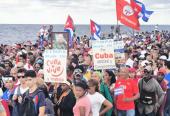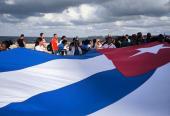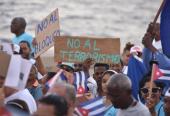Cuban Youth Under Fire: Manipulation in the Hybrid War
especiales

In recent days, following the announcement of necessary but unpopular measures in the telecommunications sector in Cuba, a deliberate attempt has been observed to manipulate university students into staging anti-government protests. These actions, far from being spontaneous, form part of a permanent strategy of non-conventional warfare directed at Cuba. The goal is to exploit the legitimate dissatisfaction of young people in order to inflame public sentiment for destabilizing purposes.
Recently, the Cuban Telecommunications Company (ETECSA) announced adjustments to its services. This decision responds to the need to ensure the sustainability of the system within a difficult economic context, further strained by the tightened economic, commercial, and financial blockade imposed by the United States. These measures have generated dissatisfaction and misunderstanding among the population, particularly among university students, who —as they themselves have expressed to the authorities— need Internet access for their studies, communication, and access to information.
The Federation of University Students (FEU) rejected media manipulation and attempts to disrupt normal university life. It emphasized the importance of preserving the educational process, especially in the current context. Meanwhile, the Secretary of the Union of Young Communists (UJC) called on young people to remain united with the Revolution, to avoid confusion, and to safeguard the university as both a space for critical thinking and a stronghold of Cuban sovereignty. This response comes in light of social media campaigns calling for "peaceful" student demonstrations, supposedly demanding better conditions. These campaigns are being promoted from abroad and are false or exaggerated. Their sole purpose is to use youth as a spearhead against the very educational institutions that nurture them and against the government itself.
These false calls to action are a key element in this manipulation strategy. They are widely disseminated through digital platforms, taking advantage of the very connectivity that the Cuban government has worked to expand, despite economic constraints. Alarmist messages, rumors of supposed repression, exaggerated narratives of hardship, and confrontational rhetoric that deny the possibility of dialogue are all designed to generate tension and erode trust in the authorities.
The actions described are part of what is known as Hybrid Warfare or Fifth-Generation Warfare. These are modern strategies that use unconventional tools such as disinformation and psychological manipulation to destabilize societies, governments, and entire nations with the aim of provoking regime change. Social networks are employed as echo chambers using refined tactics to influence public opinion and generate movements orchestrated from abroad.
Fifth-Generation Warfare focuses on manipulating perception. The main battlefield is the human mind. Cuban youth are a prioritized target because of their developmental stage, during which identity is being formed, cognitive skills are evolving from concrete to abstract thinking, and intense emotions and impulsivity are present. These traits can be exploited to generate media-impactful actions. In addition, their worldview —shaped by idealism, a commitment to social, political, or environmental causes, and a desire for autonomy coupled with resistance to authority— makes them prone to questioning established norms.
The manipulation of university youth does not rely solely on disinformation but also on exploiting these psychological traits, which make them particularly vulnerable. They are subjected to an information bombardment that targets their needs and aspirations while feeding their frustrations, offering a distorted vision of reality. This approach not only manipulates their perception but also seeks to disengage them from official channels of dialogue and participation, pushing them to act in line with external agendas.
Tactics such as "astroturfing," which simulate spontaneous social movements that are in fact orchestrated, are used. So are influencers and opinion leaders who, knowingly or unknowingly, promote foreign agendas. These strategies aim to fracture social unity, erode trust in institutions, and polarize public opinion.
A key psychological factor is the phenomenon of social pressure. Digital platforms amplify voices that incite protest, creating an illusion of consensus that may lead young people to feel, through emotional contagion, compelled to participate so as not to be seen as indifferent or cowardly. Moreover, the frustration resulting from economic hardships and the limitations caused by the blockade fosters emotional sensitivity, making messages of indignation resonate more strongly. Narratives claiming that "the government does not listen" or "the Revolution has failed" appeal to feelings of impotence and anger, aiming to weaken young people's confidence in the revolutionary project.
Another important factor is the perception of anonymity and impunity that social networks provide. This can lead young people to share or support calls to action without reflecting on their origins or consequences. This lack of critical analysis, combined with a desire to belong to a collective movement, creates fertile ground for manipulation.
Historically, youth have been used as the driving force behind so-called democratization processes. The so-called "Color Revolutions," tactics employed in various countries to overthrow governments through apparently spontaneous protests, have often targeted university students as their primary focus.
Clear examples of such influence on youth can be seen in recent history. In 2019, student protests in Hong Kong evolved into massive social demonstrations later known as the "Umbrella Revolution." That same year, the "Hirak" movement in Algeria led to student-led uprisings against President Abdelaziz Bouteflika. In 2011, student uprisings played a key role in protests against Hosni Mubarak’s government, both part of the so-called "Arab Spring."
In Latin America, we can point to the 2007 emergence of the "White Hands Movement" in Caracas, which, driven by opposition to censorship, participated in protests against the government of Hugo Chávez. The most notable case is that of Serbia in 2000, with the Otpor movement, which mobilized youth to overthrow Slobodan Milošević through civil disobedience and mass protests, also supported by foreign funding.
It is essential to recognize that in Cuba, the Revolution has always placed its trust in youth. Young people have been and will continue to be key players in the most significant achievements of the revolutionary process, including the Literacy Campaign, the victory at Playa Girón, and countless other milestones that have brought us to the present. It is both legitimate and positive for them to express their opinions, point out perceived injustices, and propose solutions. The Cuban government values this critical spirit and is committed to listening and working with them to overcome current challenges, as affirmed by the country's top leaders.
However, we must not allow our youth to be manipulated by external agents seeking to destroy what generations of Cubans have built. The Revolution will not tolerate the use of our students as tools in color revolutions that serve imperialist interests. In this critical moment, we must reflect, unite, remain alert to manipulative tactics, and above all, communicate. Let us not allow ourselves to be misled.
Translated by Sergio A. Paneque Díaz / CubaSí Translation Staff













Add new comment